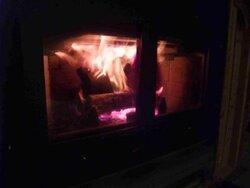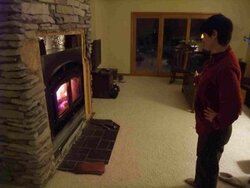Hey, all. Just had a new BIS Tradition installed earlier this week and, after completing our break-in 'small fires' to cure the refractory brick panels, I fired it up for real today. I've fed it wood all day - a combination of oak, maple, and hickory (we live among 5 acres of the stuff), and all of the wood has had over a year to season. My wife and I are stunned that there is minimal heat coming out of the unit. When I open the doors to put a log in, heat floods out. Otherwise, it is mildly warm within about 5 feet of the unit. Beyond that distance you can see the flames and hear the (loud) fan blowing at full, but there is no warmth to be felt. We have a thermostat on the wall directly opposite (and facing) the BIS - about 15 feet away - and it registers 67 degrees. Since that is what we have our propane furnace set to (and it's been keeping the rest of the house at 67 or better), it would seem that the BIS is not sharing any of its heat with us yet.
I've attached two photos in the event there's key information missing from my description. As you can see from the photos, the unit has been installed but not finished. (We wanted to make sure the unit was fully functional before encasing it in stone.) It is sitting in a hole left by a defunct Mendota unit that had to be removed. In the second photo, my wife is standing as close as she can get to the BIS without feeling ANY heat. An old-school fireplace would have been much more effective at heating this room.
One other complicating factor: we have cathedral ceilings and have not (yet) turned on our ceiling fan. I realize that the ceiling fan will help us feel the heat, but I thought I'd be able to feel something within 6 or 7 feet of this beast. The BIS has been burning full-tilt for about 8 hours now. We have both gravity vents installed. It is possible to feel a meager amount of warmth (not enough to actually warm a chilled hand) about 2 or 3 inches away from the vent, but no further.
We can tell a slight difference when we turn the fan off, but the most noticeable change is that the BIS gets quiet. There's almost no detectable air blowing out of the unit even when the fan is on max.
So what did I screw up here? Is this something I can correct, or do I need the installer to schedule a visit?
Thanks in advance, and I hope everyone else is having a nice, wood-heated weekend!
- Michael "Cincinnatux" Sullivan
I've attached two photos in the event there's key information missing from my description. As you can see from the photos, the unit has been installed but not finished. (We wanted to make sure the unit was fully functional before encasing it in stone.) It is sitting in a hole left by a defunct Mendota unit that had to be removed. In the second photo, my wife is standing as close as she can get to the BIS without feeling ANY heat. An old-school fireplace would have been much more effective at heating this room.
One other complicating factor: we have cathedral ceilings and have not (yet) turned on our ceiling fan. I realize that the ceiling fan will help us feel the heat, but I thought I'd be able to feel something within 6 or 7 feet of this beast. The BIS has been burning full-tilt for about 8 hours now. We have both gravity vents installed. It is possible to feel a meager amount of warmth (not enough to actually warm a chilled hand) about 2 or 3 inches away from the vent, but no further.
We can tell a slight difference when we turn the fan off, but the most noticeable change is that the BIS gets quiet. There's almost no detectable air blowing out of the unit even when the fan is on max.
So what did I screw up here? Is this something I can correct, or do I need the installer to schedule a visit?
Thanks in advance, and I hope everyone else is having a nice, wood-heated weekend!
- Michael "Cincinnatux" Sullivan




